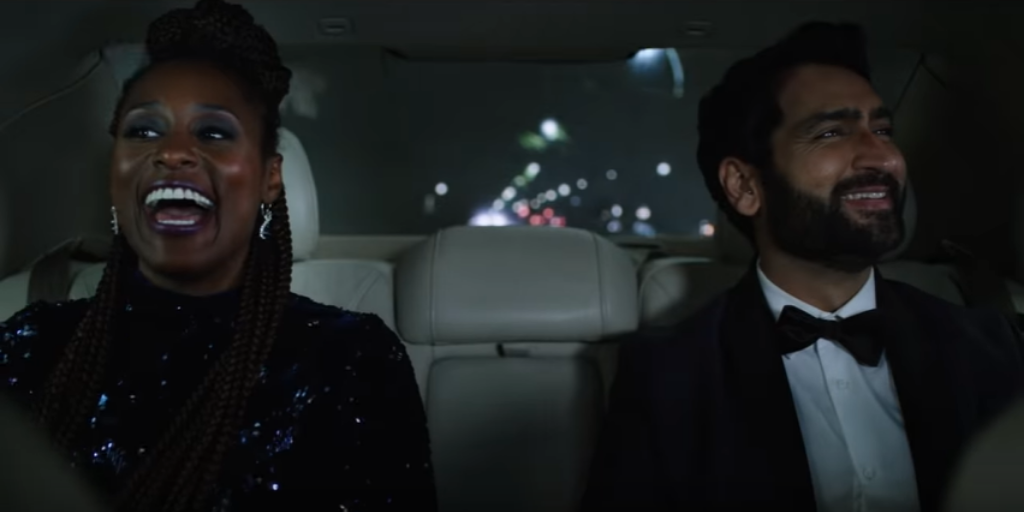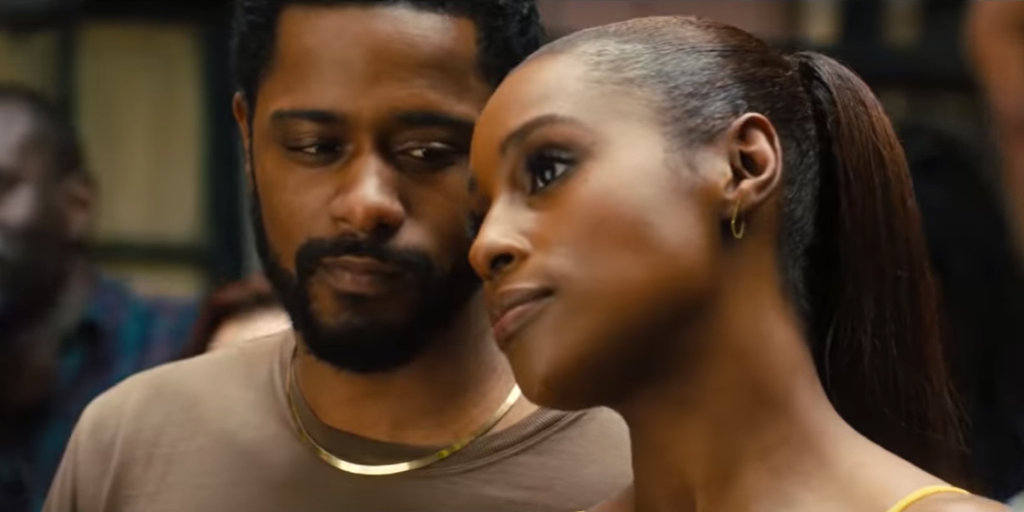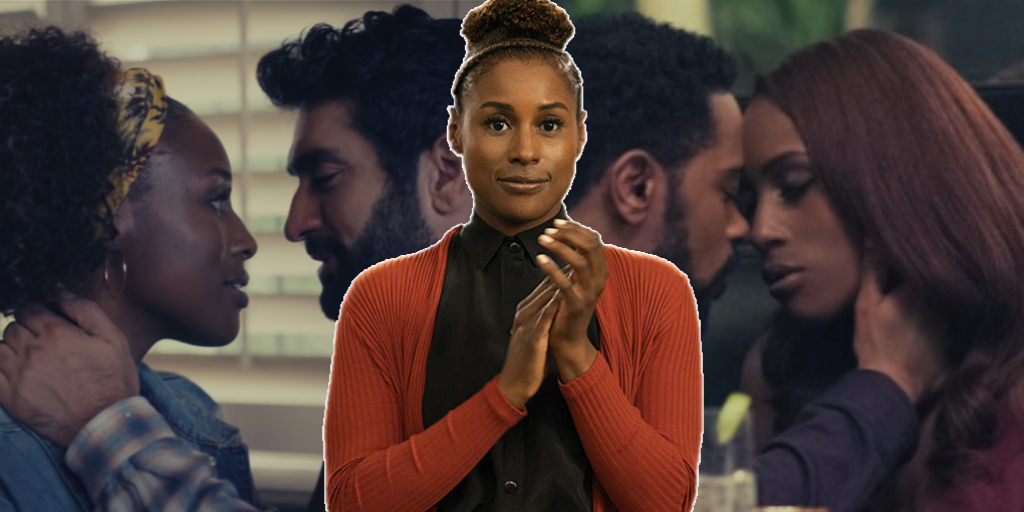Photo credits: Paramount, HBO, Universal Pictures
Hollywood has a new romantic It Girl in town—Issa Rae.
The Insecure star is the lead in two romantic films this year, February’s The Photograph, co-starring LaKeith Stanfield, and The Lovebirds, which will premiere in April and co-stars Kumail Nanjiani. To see Rae in two romantic films a few months apart is astounding to me, especially since it’s not often that we see Black women in romantic films, especially ones that are marketed towards a mainstream (i.e. white) audience.
So what makes these two films worth discussing? First of all, there’s the fact that both films are positing love with non-white leads a normal part of life. In our reality, it’s a given that people of any race can be attracted to someone of their own race or another race. We’ve seen non-white people in relationships, same-race and interracial, all around us, and indeed, the rate of interracial relationships is only rising as racial demographics become even more intertwined with each other due to merging social lives. So for those of us who observe the world around us, and indeed, for those of us who are products of non-white relationships, we are very familiar with seeing non-white people in love.
Not so for Hollywood, where the majority of romantic films are about white couples. A key example of how ubiquitous white relationships are with the romance genre is how lauded the Before Sunrise series of films are. Many consider the trilogy to be the best set of romantic films produced by Hollywood. I personally don’t see those films that way—I see them as boring and pretentious—but the point I’m making goes beyond what I personally think about those films. The point is that in the history of romantic films, which includes a whole host of films featuring non-white leads, non-white same-race couples and non-white interracial couples, the films considered the cream of the crop are films with white leads, set in a European locale no less. Objectively speaking, is Before Sunrise truly the epitome of romance films when there are so many different types of romance films to choose from?

Keep in mind, I’m not saying that romantic films with white leads are instantly terrible. I love a lot of the romance films from the Golden Age of Hollywood, such as Bette Davis’ Now Voyager and Gene Kelly and Debbie Reynolds in Singin’ in the Rain, a rom-com musical. I’ll sit and watch any film starring Kelly and a younger Frank Sinatra when they were being billed in Hollywood as a pseudo double-act in rom-com musicals. I love those films so much that I have big opinions as to why Kelly was always paired with the “glamorous” woman and why Hollywood seemed to always goose Sinatra about his looks by pairing him with women the industry felt was in his league, all the while Sinatra’s gimmick as a teenage heartthrob made girls literally throw their underwear on stage at him. (I read his biography, which shows just how much of a Sinatra fan I was.) Clearly, I love movies with white people in them.
But the issue is that movies with white people is the majority of what we’ve seen from Hollywood since its inception, and any effort to show otherwise has been tamped down in one way or another. Even now, with diversity being a big buzzword in Hollywood, people still fear it’ll be treated like a fad, just like how diversity was treated in the ‘90s with the advent of the Black entertainment renaissance, a movement that fizzled out in the early ‘00s. With that fear in the air, it’s amazing that we’re getting not just one film with non-white leads, but two. Even more incredible is that they both feature a Black woman, a woman Hollywood regularly leaves out of love stories.
Too often, Black women have been positioned as objects. Black women characters have been used as sexual objects, “mammy” figures, sassy best friends, and any other dehumanizing character trope. But rarely have we been shown to be layered humans deserving of love. And even when there are the few love stories out there featuring Black women, there’s often a level of colorism we have to overlook. There aren’t a lot of films out there showcasing darker-skinned Black women with the same care lighter-skinned Black women or white women get. Rae, being a darker-skinned Black woman herself, is rejecting the barriers that Hollywood would have inflicted upon her and is paving her own way. First with Insecure, where she is a sexually active woman trying to find her way through relationships, and now with these two films, where she portrays two different types of Black women in love.

Another amazing factor of Rae’s romantic film escapades is that The Lovebirds features a coupling we haven’t seen in American film since Mississippi Masala—a Black/South Asian relationship. These stories aren’t marketed the way Mississippi Masala or other films with Black romantic stories have been marketed, however. Rae’s films are being marketed out in the open, for mass appeal and mass consumption. Their stories are being treated as regular American stories for a multicultural and socially aware American audience. That’s cool to see.
There’s the fact that these films don’t seem to have storylines that directly tie to some inherent trauma in being non-white. If there’s any criticism I can say about certain interracial films, it’s that the storylines always seem to revolve around prejudice, racism, bias, and any other type of “woe is me” sentiment. Not saying that kind of oppression doesn’t exist; of course it does. But what’s annoying is when Hollywood keeps showing that one side of the story as if it’s the only side of the story. There’s a reason why the “tragic mulatto” is considered a trope in Hollywood storytelling. By only focusing on the racialized trauma of living in a country that puts overemphasis on a racial binary, the potential for storytelling gets funneled down into one story that gets repeated.
It is highly important for films to focus on the issues that can crop up in interracial relationships, such as the very real issues people have had with families accepting their partners and/or their children, being outcasted from social groups and feeling a sense of alienation by certain subsects of their communities in general. But, it’s just as important to show stories that feature non-white and non-white interracial relationships as being just what they are—relationships between two people. The Lovebirds and The Photograph seem to do just that.
With what I’ve seen of The Photograph, the focus isn’t on Rae and Stanfield’s characters being Black, even though their Blackness does inform their characters. The story, instead, is on Rae’s relationship with her mother and how she is living parts of her mother’s romantic life through her own relationship with Stanfield’s character. That by itself is a universal story. Similarly with The Lovebirds, Rae and Nanjiani’s characters might be informed by their racial backgrounds, but the story itself is one that focuses on relationship amid peril; in this case, their characters are framed for a murder they didn’t commit, and now they must go through hoops to solve the case to clear their names. That is a story that could use characters from any race to tell.
By focusing on the universality of romance, these two films are showcasing how people are largely the same, regardless of what background you come from. There are some commonalities we all share as humans, and that is the ability to love. With that said, doesn’t it make sense that we should have seen more films showing people of all types in love on screen? Why is the diversity in the romance genre just now taking more leaps forward? I guess the best thing to do is to not question the progress, but simply be glad it’s happening.
